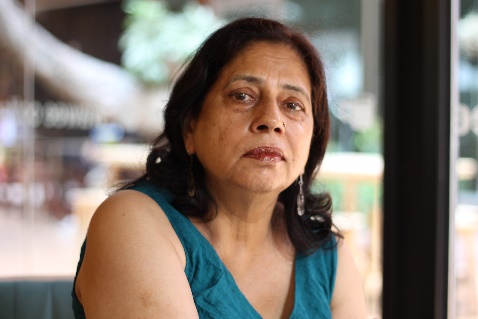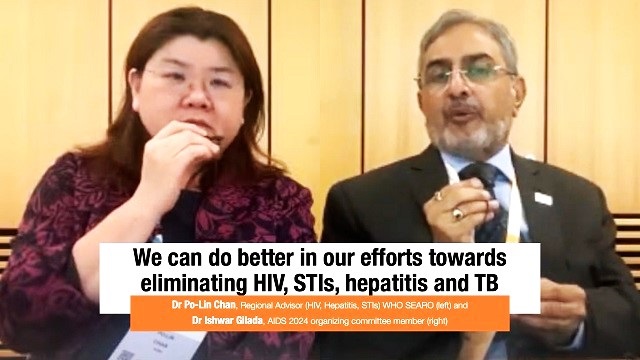


We have the science-based tools to prevent, diagnose, treat and manage all four infections: HIV, hepatitis, sexually transmitted infections (STIs) and TB. Despite this, TB has been the biggest infectious disease killer in the world till COVID-19 had hit us (but more people died of TB in high-burden countries than those who died of COVID). Now, another preventable infection, hepatitis, has emerged to kill as many people as those who died from TB in 2022 (around 1.3 million). 630,000 people died due to AIDS in 2022.
More than 1 million curable sexually transmitted infections (STIs) are acquired every day worldwide in people 15-49 years old, the majority of which are asymptomatic. In 2020 there were an estimated 374 million new infections in people 15-49 years with 1 of 4 curable STIs: chlamydia, gonorrhoea, syphilis and trichomoniasis.
“We have slid behind (in terms of progressing towards eliminating AIDS, TB, viral hepatitis and STIs). Gains made earlier were reversed during the COVID-19 pandemic years and most countries are not on track to achieve the SDG targets,” said Dr Po-Lin Chan, Regional Advisor (HIV, Hepatitis and Sexually Transmitted Infections) at the South-East Asia Regional Office of the World Health Organization (WHO). Dr Po-Lin was speaking with CNS (official media partner of AIDS 2024) at the 25th International AIDS Conference (AIDS 2024) in Munich, Germany.
After the COVID-19 pandemic are we building back better?
Dr Po-Lin gives hope: “We still have time to build back and build better. We can strengthen and accelerate health responses in Asia and the Pacific region. Countries like Cambodia and Thailand in Asia and the Pacific region have led from the front on delivering on 95-95-95 HIV-related targets but with the current trajectory they will not be able to reach the 2030 goals (of ending AIDS). Most of the other countries in the southeast Asia region such as India, Bangladesh, Nepal, Indonesia, Myanmar, DPR Korea, Timor-Leste and others are still far from achieving the 2025 and 2030 HIV-related targets. But I am an optimist and hope that countries will renew their efforts in getting towards the 2030 goals.”
95-95-95 targets refer to ensuring by 2025 that 95% of people living with HIV know their status, 95% of those who know their status are on lifesaving antiretroviral therapy, and 95% of those on therapy, remain virally suppressed.
"Persons with HIV can live healthy and fulfilling lives if viral load is undetectable. WHO says that there is zero risk of HIV transmission from a person living with HIV who is on treatment and remains virally suppressed. Which in other words is referred to as undetectable equals untransmittable (or U equals U),” explains Dr Ishwar Gilada, who is a part of AIDS 2024 organising committee and Governing Council of International AIDS Society (IAS).
Dr Gilada added that “HIV prevention has also taken a back seat in the last 10-15 years. Young people who were born before 15 years or earlier were exposed to relatively better HIV prevention messaging, campaigns and initiatives than what we do today. Those children and young people who have not been reached out with HIV prevention campaigns and services are vulnerable. This could be one reason why we see alarming number of new HIV infections in the young people.”
Combination prevention options should be accessible to all
Quite a few new HIV prevention options have proven to work scientifically in the recent past. But this has not increased the choices a person has to protect oneself from HIV acquisition.
Pre-Exposure Prophylaxis (PrEP) was approved by US FDA in 2012. PrEP helps HIV negative people reduce the risk of HIV acquisition significantly. But it has not been introduced yet in public programmes in India yet, said Dr Gilada.
Last month, a study had shown that an HIV negative woman or adolescent girl will need just two injections a year of Lenacapavir (a longacting PrEP drug) to remain safe from acquiring HIV through the sexual route. But cost is a whooping US$ 40,000 for a person per year. There is a growing call at AIDS 2024 to demand generic manufacturing of this drug to make it affordable, accessible and available everywhere (and not just in the rich nations and for the rich people).
Dr Gilada wonders why governments are not rolling out the full range of prevention options and making them accessible to those who may be at a heightened risk of HIV, STIs, hepatitis, and unplanned pregnancies. “Governments are not investing in HIV prevention options like PrEP but have programmes to provide lifelong antiretroviral therapy and care if one gets infected. Thankfully we have free treatment for people with HIV but not investing in HIV prevention fully, has no public health rationale.”
HIV self-test is also not available in government-run programmes such as in India. Although people can buy it online but it is very expensive. Lessons from making pregnancy self-test or COVID-19 self-test should guide us in making HIV self-test accessible, affordable and available to those who may want to use it, says Dr Gilada.
Dr Gilada points out that over 90% of HIV medicines taken by people worldwide – especially in low- and middle-income countries, are made in India by generic manufacturers. But are we rolling all of these medicines to our own people-in-need equitably?
First hepatitis C self-test prequalified by WHO
Dr Po-Lin Chan informed CNS that earlier this month, WHO has prequalified the first hepatitis C virus (HCV) self-test which can provide a critical support in expanding access to testing and diagnosis, accelerating global efforts to eliminate hepatitis C. Self-test for hepatitis B virus (HBV) is in the pipeline. “People need to have more choices to protect them from infections,” rightly said Dr Po-Lin. “It is not only about piloting the introduction of new innovative health technologies but also taking them to scale.”
Community-led interventions give beacon of hope
Community-led interventions have proven to work – especially when it comes to reaching-the-unreached with services – and with dignity, respect and rights. “There has been a lot of effort by a range of agencies to expand and institutionalise community-led interventions over-time. We need to move forward and institutionalise community-led monitoring as part of public health approaches,” said Dr Po-Lin.
Triple elimination
Dr Po-Lin said that WHO encourages governments to work towards triple elimination of mother to child transmission of HIV, syphilis and viral hepatitis. In South-East Asia region, countries like Thailand, Maldives and Sri Lanka have already eliminated mother to child transmission of HIV and syphilis, and now working towards eliminating HBV.
Missed opportunities
People are tested for vaccine-preventable diseases (like HBV or Human Papilloma Virus - HPV) but those eligible are not offered the respective vaccines. “Places like antenatal clinics, STIs clinics, blood banks, or during hospital admissions, people do get tested for HBV, HCV, syphilis, etc. Before surgeries, often people are tested for triple-H (HIV, HCV, HBV) but we do not offer HBV vaccine to those who test negative. INR 100 (~ USD 1) is the cost of vaccinating one person (3 doses) for HBV for life,” said Dr Gilada.
South-East Asia region has 16 million cases of 4 curable STIs (chlamydia, gonorrhoea, syphilis and trichomoniasis). 3.9 million people living with HIV are in South-East Asia. 70 million people in Southeast Asia region have HBV or HCV, shared Dr Po-Lin.
She added that “In India testing and treatment for HBV and HCV is free in the government-run programmes but uptake is low. These services are not available down to the rural areas.”
Dr Gilada said that Indian generic medicine makers have reduced the price of HCV treatment from US$ 84000 (for 84 days of treatment) to US$ 250-300 – which is 0.3% of the earlier cost charged by Big Pharma. There should be no delay in ensuring that everyone with HCV can access standard diagnostics, treatment, care and support – and all infection prevention options are accessible too in a people-centred and rights-based manner.
Dr Gilada was a part of the Indian government’s expert committee that had recommended the introduction of shorter course for latent TB (1 month therapy of rifapentine and isoniazid). This was 4 years ago but even now this treatment is yet to be made available to everyone eligible. “Company which makes it is in India and supplies it to the world, but we are yet to provide the latest TB preventive treatment to our own people.”
Dr Gilada questions why TB-LAM test is not available in India. TB-LAM test finds TB early among people living with HIV – it is only available for research purposes in the country. It is 9 years now since WHO guidelines recommended TB LAM test as it has better sensitivity for diagnosing TB among people with HIV. Its sensitivity is even greater for those with lower CD4 counts.
There should be no delay between the time when scientific breakthroughs happen (like TB LAM test) and by the time they reach the people and are deployed equitably to fully yield the public health gains. TB LAM point-of-care test is based on the detection of mycobacterial lipo-arabino-mannan (LAM) antigen in urine.
No place for head-in-sand approach
“We cannot have a head-in-sand approach – on one hand, our governments have promised to eliminate TB by 2025 in India (and 2030 globally), AIDS, viral hepatitis and STIs by 2030, and on another hand, we are not deploying best of diagnostics, treatments, and disease prevention options equitably,” said Dr Gilada.
Many people with HIV are dying of TB. We need to find TB early and accurately among people with HIV and deploy best of diagnostic tools (for TB of the lungs as well as of other parts of the body), said Dr Gilada.
Dr Po-Lin points out that out of 11 countries in South-East Asia region, 9 had responded to a survey which shows that 20-60% of people newly diagnosed with HIV may have advanced HIV disease (AHD). AHD puts them at a greater risk of TB, cryptococcal meningitis or other opportunistic infections.
We can do better because we have the scientific tools to prevent, diagnose, treat and care for people with TB, HIV, viral hepatitis or STIs – and – we have the demonstrated evidence from the communities in making a difference.
(Shobha Shukla is the award-winning founding Managing Editor and Executive Director of CNS (Citizen News Service) and is a feminist, health and development justice advocate. She is a former senior Physics faculty of prestigious Loreto Convent College and current Coordinator of Asia Pacific Regional Media Alliance for Health and Development (APCAT Media) and Global AMR Media Alliance (GAMA). Follow her on Twitter @shobha1shukla or read her writings here www.bit.ly/ShobhaShukla)